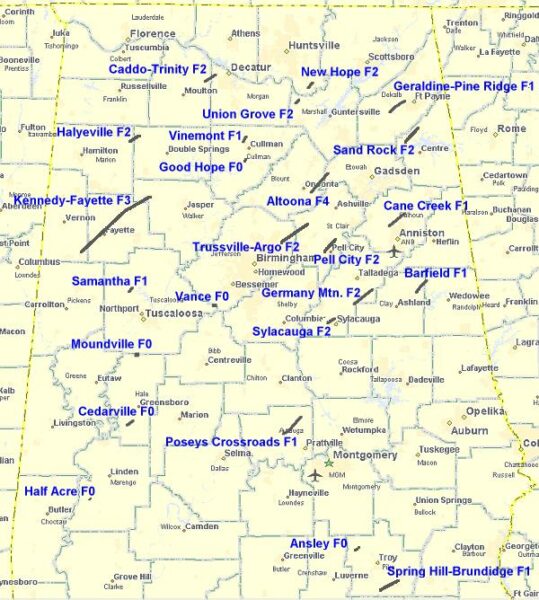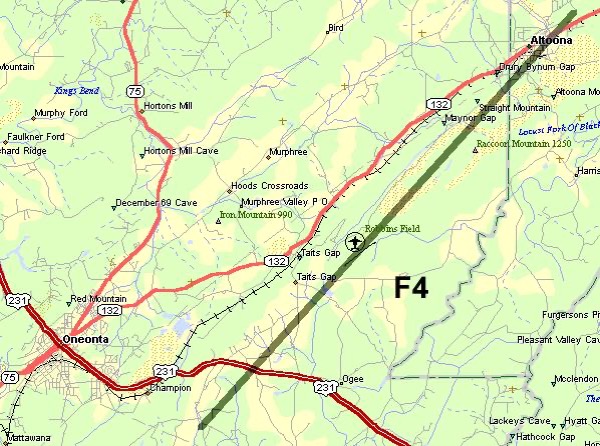On This Date in 2001: A Destructive November Alabama Tornado Outbreak
On this date in 2001, Alabama experienced a historic and devastating tornado outbreak that set a record at the time for the most tornadoes in a single day in the state. Over the course of just one Saturday, 36 tornadoes touched down, shattering the previous state record of 27 tornadoes set during the infamous Super Outbreak of April 3, 1974. Remarkably, this event occurred during Alabama’s secondary tornado season in the fall, not the primary severe weather season in the spring. Of course, we know that tornadoes know no season in Alabama.
In an average year, Alabama sees approximately 43-44 tornadoes—meaning this single day nearly matched nearly an entire year’s worth of tornado activity. The outbreak would hold the record until the devastating events of April 2011, which saw even greater outbreaks of severe weather. On April 15th that year, Alabama saw 45 tornadoes, and that mark was surpassed less than two weeks later in the tragic April 27th outbreak.
A DAY OF DESTRUCTION
The November 24, 2001 tornadoes carved paths of destruction across the state, leaving death and injury in their wake. The first major tornado of the day began near Kennedy in Lamar County, tracking an impressive 39 miles southeast to just south of Carbon Hill in Walker County. Tragically, two people lost their lives in a mobile home near Kennedy, highlighting the vulnerability of such structures during severe weather.
Shortly after, at around 11:30 a.m., an F2 tornado struck Haleyville in Winston County, cutting a short but impactful path through the town and injuring 13 people. Later in the day, another F2 tornado tracked near Argo in northeastern Jefferson County along Interstate 59, causing damage as it moved into St. Clair County.
THE STRONGEST TORNADO OF THE OUTBREAK
The most powerful tornado of the day touched down just southeast of Oneonta in Blount County at approximately 1:19 p.m. This F4 tornado caused three distinct areas of severe damage along its path, with winds capable of completely leveling structures. Fortunately, no fatalities were reported from this tornado, though its strength served as a stark reminder of the deadly potential of severe storms.
TRAGEDY IN CHEROKEE COUNTY
Later in the afternoon, an F2 tornado struck near Sand Rock in Cherokee County. This tornado tragically took two lives—once again in a mobile home—and left behind an 8-mile path of destruction. Mobile homes accounted for all the fatalities during this outbreak, underscoring their inherent risks during tornadoes.
A CLOSE CALL IN PELL CITY
One of the most fortunate outcomes of the day occurred in Pell City, where an F2 tornado formed on the western side of town at 3:10 p.m. The storm weakened as it moved through downtown Pell City, resulting in only light structural damage. Had the tornado maintained its strength, the results could have been far more devastating.
A REMARKABLE OUTBREAK DURING FALL
While spring is typically considered the peak severe weather season in Alabama, the state’s secondary tornado season in late fall often brings significant outbreaks. This event serves as a stark reminder that severe weather can strike at any time of year in the Deep South.
As we remember this historic day, it’s a call to action to ensure all Alabamians have a severe weather safety plan, especially those in vulnerable structures like mobile homes.
For more on Alabama’s tornado history and how to stay safe during severe weather, continue to check out the AlabamaWX weather blog.
Category: Alabama's Weather, ALL POSTS, Severe Weather, Social Media



















